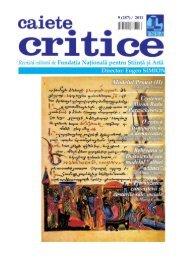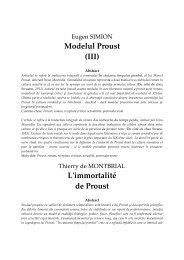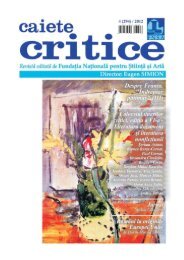Tot despre modelul grec în cultura română: parabole ... - Caiete Critice
Tot despre modelul grec în cultura română: parabole ... - Caiete Critice
Tot despre modelul grec în cultura română: parabole ... - Caiete Critice
You also want an ePaper? Increase the reach of your titles
YUMPU automatically turns print PDFs into web optimized ePapers that Google loves.
Romanticism and Chaos Theory<br />
kinesis [...] all these are different aspects of<br />
the same polarity of configuration”. 15<br />
Kepes’ perspective here is similar to<br />
Ralph Waldo Emerson’s view according to<br />
which there are two secrets of nature:<br />
“motion or change, and identity or rest”;<br />
and to Arthur Koestler’s view: “the universe<br />
is made of only one stuff with a finite<br />
set of basic geometrical patterns in an infinite<br />
number of dynamic variations” 16 .<br />
In the evolution of arts there are, on<br />
the other hand, according to Wladyslaw<br />
Tatarkiewicz, three movements: primitivism,<br />
maturity and decadence. This is the<br />
archetypal creation-destruction cycle which<br />
chaos theory empirically observed. The<br />
three movements correspond to the specific<br />
periods, the romantic, the classic, and the<br />
baroque 17 . This phenomenon reflects the<br />
transformational dynamics of the <strong>cultura</strong>l<br />
phenomenon as a dynamic mode of the<br />
spirit.<br />
For romanticism, as Friedrich Schlegel<br />
had pointed out, the fact is significant that<br />
art, and especially poetry, does not move<br />
through history as though through an indifferent<br />
medium which does not influence<br />
expression; on the contrary, even the<br />
essence of art is involved in the process of<br />
evolution – this idea is considered by<br />
Katharine Everett Gilbert and Helmut Kuhn<br />
as being Schlegel’s main contribution to aesthetics<br />
18 .<br />
In other words, the romantics saw in history<br />
and art, science and poetry, man and<br />
nature, an evolutionary monad of the spirit.<br />
Romantics like Novalis, William Blake,<br />
John Clare, John Keats, Mary Shelley, etc.,<br />
valorize disorder, the negation of order.<br />
Novalis sees in genius the one who intertwines<br />
all extremes, Blake praises excess as<br />
a way towards wisdom, Clare speaks about<br />
“disordered graces” of nature or even about<br />
the “disordely divine”, Keats speaks of the<br />
birth of a poem like the leaves and branches<br />
of a plant, Mary Shelley uses the monstrous<br />
dimension, potential in any scientific<br />
attempt, to throw light on a potential future<br />
of mankind which might come to pass if<br />
man does not evolve intellectually to a complexity<br />
that should match the complexity of<br />
the scientific knowledge accumulated exponentially<br />
as we move on in time and history.<br />
It is also interesting to notice that,<br />
although John Clare for instance didn’t<br />
know much grammar, this fact, ignoring<br />
therefore the rules of grammar (which<br />
points to a disorder on a linguistic level),<br />
paradoxically led to the creation of many<br />
beauties, as John Taylor 19 noticed.<br />
Disorder or chaos is thus seen by the<br />
romantics as a manifestation of freedom,<br />
without which for romantics there can hardly<br />
be any beauty whatsoever, even if such<br />
risks are involved as pointed out by Mary<br />
Shelley.<br />
Novalis understands “disordered” as the<br />
progressive, therefore the romantic.<br />
Likewise, Blake proclaims, through Orc, the<br />
energy at the basis of creation, revolution as<br />
an absolute necessity on the path towards<br />
salvation.<br />
Through her negative example of the<br />
uses of science, Mary Shelley most likely<br />
envisages a revolution in the ways in which<br />
science is to be tackled – namely with<br />
increasing human responsibility as the levels<br />
of global complexity increase, with a<br />
view to preserving this pristine freedom of<br />
life devoid of man’s artificial constructs,<br />
which however, if accepted as part of<br />
nature’s plan, should not diminish that natural<br />
pristine freedom, but should expand it<br />
– human civilization being a total experiment<br />
for the creation of more freedom and<br />
not for the creation of forms of slavery, intellectual,<br />
natural, social, political, or othwerwise.<br />
15 G. Kepes, The New Landscape, 1956, pp. 286-287, apud Arthur Koestler, The Act of Creation, 1989, p. 389.<br />
16 Arthur Koestler, The Act of Creation, 1989, p. 389.<br />
17 Wladyslaw Tatarkiewicz, Istoria esteticii, vol. 1-4, 1978, vol. 1 Estetica Anticã, pp. 82-83.<br />
18 Katharine Everett Gilbert ºi Helmut Kuhn, Istoria Esteticii, 1972, p. 332.<br />
19 John Taylor, Introduction to Poems Descriptive of Rural Life and Scenery, January 1820, apud Mark Storey,<br />
ed., John Clare, The Critical Heritage, 1995, p. 47.<br />
55







